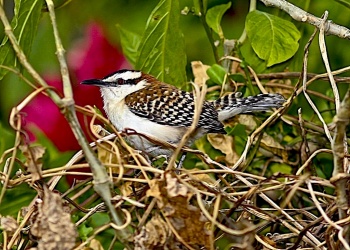- Campylorhynchus rufinucha
Includes: Sclater's Wren; Rufous-backed Wren
Identification
17cm
- Black crown and eyestripe
- White supercilium
- Rufous nape
- Cinnamon-brown upperparts with black and white streaks
- White underparts
- Wings and tail are barred with black and greyish-white
Young birds have duller upperparts and buff underparts
Sexes similar.

Photo by Stanley Jones
Santo Domingo, Heredia Province, Costa Rica, February 2014
Distribution
North and Central America: found in Mexico, Costa Rica, Guatemala, Honduras, El Salvador and Nicaragua.
Taxonomy
This species has in the past been treated as three species and a new paper is proposing to use that treatment again. These are here treated as groups:
- C.r. rufinucha is an isolated population on the plains of east-central Veracruz and adjacent Oaxaca Mexico. This is medium in size. The resulting species would be monotypic.
- C.r. humilis is a small form found along the Pacific coast of Mexico south to about Laguna La Joya in the western Isthmus of Tehuantepec. The resulting species would be monotypic. (Sclater's Wren)
- C.r. capistratus is a large form found along the Pacific coast from Laguna La Joya to northern Costa Rica. This form would include existing subspecies C.r. nigricaudatus, xerophilum, nicaraguae, and castaneus. (Rufous-backed Wren)
Near Laguna la Joya is a population of medium size that probably originated as a hybrid population when the large and the small forms came into secondary contact. The paper referred to above argue that this is a narrow, stable zone of contact.
Habitat
Forest or open woodland, scrub, second growth and savanna. Urban areas, manicured grounds, mix of native and horticultural plants; observed at heights around 1,158 m.
Behaviour
Breeding
The female incubates the 3-5 brown (or black-spotted white eggs) in a rounded nest with a side entrance. The eggs hatch after 2 weeks, with the young fledging two weeks later.
Diet
The diet includes insects, spiders and other invertebrates, possibly also some vegetation at times.
References
- Handbook of the Birds of the World Alive (retrieved May 2014)
- Abstract of a new paper evaluating the taxonomy of Rufous-naped Wren.
- Wikipedia
Recommended Citation
- BirdForum Opus contributors. (2024) Rufous-naped Wren. In: BirdForum, the forum for wild birds and birding. Retrieved 1 November 2024 from https://www.birdforum.net/opus/Rufous-naped_Wren
External Links
GSearch checked for 2020 platform.1




